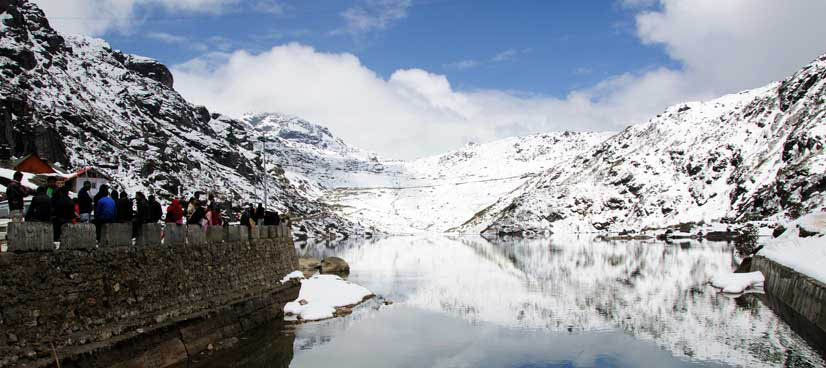


The serene landlocked state Sikkim is blessed with abundance of natural beauty and is known for being a pilgrim centre housing many sacred and religious places one of them being Tsomgo Lake. Tsomgo Lake, also known as Tsongmo Lake or Changu Lake, is a glacial lake in the East Sikkim of the Indian state of Sikkim. Perched at an elevation of 3753mt amidst the mountainous valley of Sikkim, Tsomgo Lake is one of the highest altitude lakes of India. In Bhutia language the name Tsomgo is made of two words “Tso” meaning “lake” and “Mgo” meaning “head” which give the literal meaning as “source of the lake”.
Cuddled amidst the lofty mountains Tsomgo Lake is regarded as the ethereally beautiful lake by the Hindus and the local Buddhists. Tsomgo Lake is located 40km from Gangtok near Indo-China Border on the way to Nathula. Adorned with many myths and legend the deep blue colored oval shaped Tsomgo Lake offers one of the most surreal landscape view of Sikkim. Tsomgo Lake derives its water from the melting snow of the mountains enclosing the lake. Different season unveils a different look of this legendary lake. In winter the placid lake remains frozen with the area around it covered in snow while in late spring the profusion of flowers in bloom adds a riot of colors around the lake. Tsomgo Lake’s surface reflects different colors with change of seasons and is held in great reverence by the local Sikkimese people. Buddhist monks prognosticated the future after studying the changing colors of the lake. Tsomgo Lake also plays a significant role for the Jhakris, faith healers of Sikkim, who gather here every year on the occasion of Guru Purnima to derive benefits from the healing qualities of the lake waters. The journey towards this scenically blessed glacial Tsomgo Lake is an unforgettable experience in itself. Travelling on the spiraling road cutting through the lofty mountain with the scenic view of changing landscape of rugged terrains, waterfalls and occasional glimpse of snow capped Himalayan Range is a sight to be adorned in the blissful journey towards Tsomgo Lake. A small bridge just at the entrance of the lake will take the visitors to a viewpoint cum cafeteria, from where they can witness the panoramic vista of Tsomgo Lake with its surrounding mountains. There is a quaint temple dedicated to Lord Shiva situated near Tsomgo Lake. The unique location of Tsomgo Lake creates an ideal ambiance for housing Brahmini Ducks being a favorite stopover to other species of migratory birds making Lake Tsomgo a paradise for avid bird watcher during summer and autumn season when the valley is bursting with the color riot of blooming flowers. There are many things to do around Tsomgo Lake for tourist visiting the glacial lake the famous one being Yak Safari. Riding on a back of a hairy beast while watching the enthralling view of Tsomgo Lake can be an experience to be cherished life time. Adventurer visiting to Changu or Tsomgo Lake can go for trekking at the Kyongnosla Alpine Sanctuary. Rich in both flora and fauna this sanctuary is situated in the area adjoining Lake Tsomgo. The sacred lake Tsomgo is blessed with breathtaking pictorial views of rugged mountainous valley a sight which has left many visitors spell bound by its surreal natural beauty.
Strategically located amidst the mountainous valley in Eastern district of Sikkim, the glacial Tsomgo Lake has become a must visit tourist destination of Sikkim. To witness the mist slowing lifting from the lake while the sun ray glaze Tsomgo Lake with an orange hue making it glitter like covered with precious jewel is an astounding phenomena which has ensnared the heart of travelers visiting Lake Tsomgo. Be it in winter when the lake is completely frozen or summer when the lake is gleaming under the sun, the mesmerizing charisma of Lake Tsomgo has never ceased to amaze the viewers.
The beauty of Lake Tsomgo or Changu Lake can be adorned throughout the year. During winter from January to mid May Changu Lake is completely covered in snow and tourist can enjoy trekking as well as Yak ride on snow along the coasts of the lake. From October to December, the lake is partly covered in sheet ice and migratory birds can be seen waddling in the lake’s water and to witness the vibrant color riot of rhododendron and primulas around Lake Tsomgo April to May is the best time to visit Changu Lake. It is advised be careful while traveling in the hilly region during monsoon season as the roads become more prone to landslide after a heavy rainfall causing a road block.
Do not hesitate to call us or give a missed call our expert team willhelp you and we are happy to talking with you.
+91 98765-43210
help@northbengaltourism.com